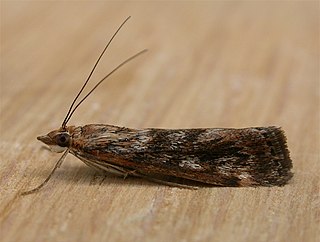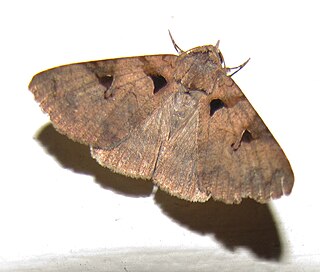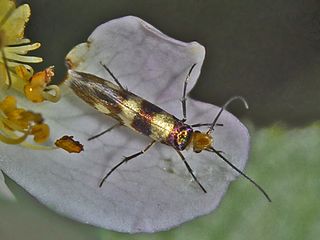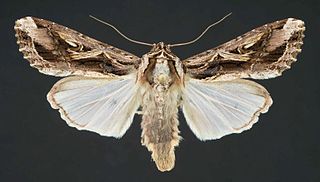
Paracolax tristalis, the clay fan-foot, is a litter moth of the family Erebidae. The species was first described by Johan Christian Fabricius in 1794. It is found in the Palearctic realm.

Achyra is a genus of moths of the family Crambidae described by Achille Guenée in 1849.

Achyra rantalis, the garden webworm, is a moth of the family Crambidae described by Achille Guenée in 1854. It is found in North America, where it has been recorded from Maine to southern Quebec and Ontario, south to Florida and Mexico. It has also been recorded from Iowa, Colorado, California and the West Indies. Its habitat consists of fields and gardens.

Speiredonia mutabilis is a species of moth of the family Erebidae first described by Johan Christian Fabricius in 1794. It is found in India, Sri Lanka, Vietnam, Taiwan, the Philippines, from Sundaland eastwards to Australia, the Solomon Islands, New Caledonia, Vanuatu, Fiji and Tonga.

Avatha discolor is a species of moth of the family Erebidae. It is found from the Indo-Australian and Pacific tropics to as far east as Henderson Island.

Simplicia cornicalis is a litter moth of the family Erebidae. The species was first described by Johan Christian Fabricius in 1794. It is found in south-eastern Asia and the Pacific. Records include New Caledonia, Réunion, Thailand, Fiji, Hawaii, India, Sri Lanka, the Society Islands, as well as New South Wales and Queensland in Australia. It is an introduced species in southern Florida and Louisiana in the United States.

Micropterix allionella is a moth of the family Micropterigidae. It was described by Johan Christian Fabricius in 1794.

Oraesia emarginata is a species of moth of the family Erebidae first described by Johan Christian Fabricius in 1794. It is found in Australia, New Caledonia, Indonesia, New Guinea, Pakistan, the Philippines, India, Sri Lanka, Sulawesi, Taiwan, China, Japan, Korea and Nepal as well as Eritrea, Ethiopia, Kenya, Namibia, Nigeria, South Africa, Tanzania, the Gambia, Uganda, Oman and Yemen.

Achyra massalis, the ombava, is a moth of the family Crambidae. The species was described by Francis Walker in 1859. It is found in most of the Old World tropics, including Réunion, Namibia and Australia.

Spodoptera dolichos, the dolichos armyworm moth or sweetpotato armyworm moth, is a moth of the family Noctuidae. The species was first described by Johan Christian Fabricius in 1794. It is found from the southern United States, south through Costa Rica to South America, as far south as Argentina. In the United States, it may occur as far north as Kentucky and Maryland.

Agathia laetata is a species of moth of the family Geometridae which was first described by Johan Christian Fabricius in 1794. It is found in India, Indochina, southern China, Taiwan and Sundaland.
Amyna punctum is a moth of the family Noctuidae first described by Johan Christian Fabricius in 1794. This moth can be found throughout subtropical African countries such as South Africa, Madagascar and Australasian countries like India, Sri Lanka, the Philippines, Borneo and the Andaman Islands.

Pycnarmon cribrata is a moth of the family Crambidae. It is known from Kenya, Zambia, Sierra Leone, South Africa Malawi, Mozambique, the Democratic Republic of the Congo, Zambia and Zimbabwe.

Haplotinea insectella, the drab clothes moth or fungus grain moth, is a moth of the family Tineidae. It was described by Johan Christian Fabricius in 1794. It is found in all of Europe, except Ireland, the Iberian Peninsula and the western and southern part of the Balkan Peninsula. It is also found in North America. The species is often found in warehouses, granaries, mills and farm buildings.
Lygropia tripunctata, the sweetpotato leafroller, is a moth in the family Crambidae. It was described by Johan Christian Fabricius in 1794. It is found in the United States, where it has been recorded from Texas to South Carolina and Florida. It is also found from the West Indies and Central America to Brazil.
Polygrammodes eleuata, the red-spotted sweetpotato moth or many-spotted moth, is a moth in the family Crambidae. It was described by Johan Christian Fabricius in 1777. It is found in Central and South America, on the Antilles and in the southern United States, where it has been recorded from Florida.
Acontia marmoralis is a moth of the family Noctuidae first described by Johan Christian Fabricius in 1794. It is found in Sri Lanka, India, Japan and Taiwan.

Epinotia abbreviana is a moth of the family Tortricidae. It is found in Europe and was first described by Johan Christian Fabricius in 1794.













